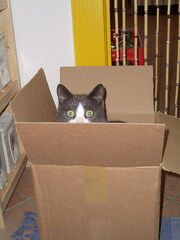
a cat peeking out of a cardboard box
Cardboard serves many purposes in our homes. Maybe the most common is cardboard boxes for shipping and holding other contents. We also use it for insulation, to make models, toys and costumes, to patch holes in walls or windows, and for lightweight furnishings.
Cardboard comes in different varieties: flat, thin sheets that may have a glossy coat and inked colors, like cereal or other food boxes (also known as paperboard), corrugated -- 2 outside sheets with a wavy or rippled sheet in between (flutes) -- stronger and thicker than 3 flat sheets would be.
Advantages[]
Cardboard is generally inexpensive. It's normally made from wood or other renewable resources. Most cardboard is reusable and recyclable.
Cautions[]
While strong for it's weight, cardboard boxes are not usually constructed to support much weight; they don't usually make good step stools or seats. The exception is some companies that now specialize in making cardboard furniture or selling kits or instructions for making your own.
Cardboard is not usually treated with fire retardant, so in case of a fire it provides material that will allow the fire to grow quickly.

This ripped piece of cardboard shows the smooth outer surface and the inner corrugation (rippled piece) that makes corrugated cardboard strong for its weight and size.
The ink or coating on some cardboard may not be safe for burning (in the fireplace or incinerator).
Related[]
References[]
- Wikipedia's article on cardboard
- Instabox on Corrugated Cardboard Types (info on the different flutes, or rippled part and some variations on the flat or wall part)